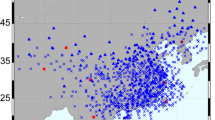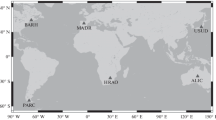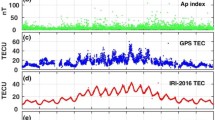Abstract
In order to adapt the International Reference Ionosphere (IRI) model from ionospheric climatological model to near real-time weather predictions, total electron content (TEC) data from Global Ionosphere Maps are ingested into the IRI-2016 model through retrieving the optimal ionospheric index (IG) over Europe on an hourly basis. When the retrieved hourly effective IG indices are used to drive the IRI-2016 model, the resulting ionospheric parameters are externally evaluated with respect to multiple sources, including the COSMIC/ionosonde electron density (Ne) profiles, ionosonde F2 layer critical frequency (foF2), and individual GNSS-derived TEC for both quiet and storm conditions. Results show that: (1) The updated IG indices for different latitudinal zones tend to follow a similar trend under quiet conditions, but vary much more significantly during storm days. (2) The retrieved Ne profiles from the updated IRI-2016 agree better with those from the COSMIC Ne profiles, especially for the F2 layer maximum electron density (NmF2) values. Furthermore, the updated IRI-2016 Ne profiles show improved agreement with ionosonde measurements under quiet conditions, particularly for the bottom-side Ne profiles and NmF2 as well as for the storm-time Ne profiles. (3) Comparing the IRI-updated TEC with the GNSS-derived TEC, IRI-updated TEC improved approximately 19% for both quiet and storm days, and the nighttime TEC improvement is better than that during daytime. When compared to the ionosonde foF2 measurements, the daytime IRI-updated foF2 improvement during quiet time is better than that during storm condition, while the performance for nighttime foF2 drops during quiet time. Discussions about possible reasons for the nighttime foF2 degradation are included.
















Similar content being viewed by others
References
Aa E, Ridley AJ, Huang W, Zou S, Liu S, Coster AJ, Zhang SR (2018) An ionosphere specification technique based on data ingestion algorithm and empirical orthogonal function analysis method. Space Weather. https://doi.org/10.1029/2018SW001987
Afraimovich EL, Astafyeva EI, Oinats AV et al (2008) Global electron content: a new conception to track solar activity. Ann Geophys: Atmos Hydrosp Space Sci 26(2):335
Araujo-Pradere EA, Fuller-Rowell TJ, Codrescu MV (2002) STORM: An empirical storm-time ionospheric correction model 1: Model description. Radio Sci 37(5):3-1-3-12
Arikan F, Erol CB, Arikan O (2003) Regularized estimation of vertical total electron content from global positioning system data. J Geophys Res: Space Phys. https://doi.org/10.1029/2002ja009605
Arikan F, Erol CB, Arikan O (2004) Regularized estimation of vertical total electron content from GPS data for a desired time period. Radio Sci. https://doi.org/10.1029/2004rs003061
Arikan F, Arikan O, Erol CB (2007) Regularized estimation of TEC from GPS data for certain midlatitude stations and comparison with the IRI model. Adv Space Res 39(5):867–874. https://doi.org/10.1016/j.asr.2007.01.082
Arikan F, Nayir H, Sezen U, Arikan O (2008) Estimation of single station interfrequency receiver bias using GPS-TEC. Radio Sci 43(4):RS4004. https://doi.org/10.1029/2007rs003785
Astafyeva E, Zakharenkova I, Förster M (2015) Ionospheric response to the 2015 St. Patrickˈs Day storm: a global multi-instrumental overview. J Geophys Res Space Phys 120:9023–9037. https://doi.org/10.1002/2015JA021629
Bilitza D, Bhardwaj S, Koblinsky C (1997) Improved IRI predictions for the GEOSAT time period. Adv Space Res 20:1755–1760. https://doi.org/10.1016/S0273-1177(97)00585-1
Bilitza D, McKinnell L-A, Reinisch B, Fuller-Rowell T (2011) The international reference ionosphere today and in the future. J Geod 85:909–920. https://doi.org/10.1007/s00190-0100427-x
Bilitza D, Altadill D, Zhang Y, Mertens C, Truhlik V, Richards P, McKinnell LA, Reinisch B (2014) The international reference ionosphere 2012-a model of international collaboration. J Space Weather Space Clim 4:A07. https://doi.org/10.1051/swsc/2014004
Bilitza D, Altadill D, Truhlik V et al (2017) International Reference Ionosphere 2016: from ionospheric climate to real-time weather predictions. Space Weather 15(2):418–429
Birch MJ, Hargreaves JK, Bailey GJ (2002) On the use of an effective ionospheric height in electron content measurement by GPS reception. Radio Sci 37(1):1. https://doi.org/10.1029/2000rs002601
Brown S, Bilitza D, Yigit E (2017) Ionosonde-based indices for improved representation of solar cycle variation in the international reference Ionosphere model. J Atmosph Solar-Terr Phys. https://doi.org/10.1016/j.jastp.2017.08.022
Brunini C, Camilion E, Azpilicueta F (2011) Simulation study of the influence of the ionospheric layer height in the thin layer ionospheric model. J Geod 85(9):637–645. https://doi.org/10.1007/s00190-011-0470-2
Chen Y, Liu L, Wan W (2011) Does the F 10.7 index correctly describe solar EUV flux during the deep solar minimum of 2007–2009. J Geophys Res Space Phys 116:A04304. https://doi.org/10.1029/2010JA016301
Cherniak I, Zakharenkova I (2016) NeQuick and IRI-Plas model performance on topside electron content representation: spaceborne GPS measurements. Radio Sci 51(6):752–766
Cherniak I, Zakharenkova I, Redmon RJ (2015) Dynamics of the high-latitude ionospheric irregularities during the 17 March 2015 St. Patrickˈs Day storm: ground-based GPS measurements. Space Weather 13:585–597. https://doi.org/10.1002/2015SW001237
Crowley G et al (2006) Global thermosphere-ionosphere response to onset of 20 November 2003 storm. J Geophys Res 111:A10S18. https://doi.org/10.1029/2005ja011518
Danilov AD (2013) Ionospheric F-region response to geomagnetic disturbances. Adv Space Res 52(3):343–366. https://doi.org/10.1016/j.asr.2013.04.019
Foster JC, Coster AJ, Erickson PJ et al (2005) Multiradar observations of the polar tongue of ionization. J Geophys Res 110:A09S31. https://doi.org/10.1029/2004JA010928
Gulyaeva TL, Arikan F, Sezen U et al (2018) Eight proxy indices of solar activity for the international reference ionosphere and plasmasphere model. J Atmos Solar Terr Phys 172:122–128
Habarulema JB, Ssessanga N (2017) Adapting a climatology model to improve estimation of ionosphere parameters and subsequent validation with radio occultation and ionosonde data. Space Weather 15(1):84–98
Hernandez-Pajares M, Juan JM, Sanz J, Bilitza D (2002) Combining GPS measurements and IRI model values for space weather specification. Adv Space Res 29(6):949–958. https://doi.org/10.1016/S0273-1177(02)00051-0
Huang X, Reinisch BW (1996) Vertical electron density profiles from digisonde ionograms: The average representative profile. Ann Geofis XXXIX(4):751–756
Huang CS, Foster JC, Goncharenko LP, Erickson PJ, Rideout W, Coster AJ (2005) A strong positive phase of ionospheric storms observed by the Millstone Hill incoherent scatter radar and global GPS network. J Geophys Res 110:A06303. https://doi.org/10.1029/2004JA010865
Klimenko MV, Klimenko VV, Zakharenkova IE, Cherniak IV (2015) The global morphology of the plasmaspheric electron content during Northern winter 2009 based on GPS/COSMIC observation and GSM TIP model results. Adv Space Res 55:2077–2085. https://doi.org/10.1016/j.asr.2014.06.027
Komjathy A, Langley R (1996) Improvement of a global ionospheric model to provide ionospheric range error corrections for single-frequency GPS users. In: Proceedings of the 52nd annual meeting of the institute of navigation, Cambridge, MA, June 1996. pp 557–566
Lanyi GE, Roth T (1988) A comparison of mapped and measured total ionospheric electron content using global positioning system and beacon satellite observations. Radio Sci 23(4):483–492
Lei J et al (2007) Comparison of COSMIC ionospheric measurements with ground-based observations and model predictions: preliminary results. J Geophys Res 112:A07308. https://doi.org/10.1029/2006JA012240
Li M, Yuan Y, Zhang B et al (2018) Determination of the optimized single-layer ionospheric height for electron content measurements over China. J Geodesy 92(2):169–183
Liu R, Smith P, King J (1983) A new solar index which leads to improved foF2 predictions using the CCIR Atlas. Telecommun J 50:408–414
Liu L, Yao Y, Kong J, Shan L (2018) Plasmaspheric electron content inferred from residuals between GNSS-Derived and TOPEX/JASON vertical TEC data. Remote Sens 10(4):621
Mannucci AJ, WilsonBD Yuan DN, HoCH LindqwisterUJ, Runge TF (1998) A global mapping technique for GPS-derived ionospheric total electron content measurements. Radio Sci 33(3):565–582. https://doi.org/10.1029/97rs02707
Migoya-Orué Y, Nava B, Radicella S, Alazo-Cuartas K (2015) GNSS derived TEC data ingestion into IRI 2012. Adv Space Res 55(8):1994–2002
Nava B, Radicella SM, Leitinger R, Coïsson P (2007) Use of total electron content data to analyze ionosphere electron density gradients. Adv Space Res 39(8):1292–1297. https://doi.org/10.1016/j.asr.2007.01.04
Nava B, Coisson P, Radicella SM (2008) A new version of the NeQuick ionosphere electron density model. J Atmos Solar Terr Phys 70(15):1856–1862
Nayak C, Tsai LC, Su SY, Galkin IA, Tan ATK, Nofri E, Jamjareegulgarn P (2016) Peculiar features of the low-latitude and midlatitude ionospheric response to the St. Patrick’s Day geomagnetic storm of 17 March 2015. J Geophys Res Space Phys 121:7941–7960. https://doi.org/10.1002/2016JA022489
Nayir H, Arikan F, Arikan O, Erol CB (2007) Total electron content estimation with Reg-Est. J Geophys Res: Space Phys. https://doi.org/10.1029/2007ja012459
Okoh D, McKinnell LA, Cilliers P et al (2013) Using GPS-TEC data to calibrate VTEC computed with the IRI model over Nigeria. Adv Space Res 52(10):1791–1797
Pedatella NM, Yue X, Schreiner WS (2015) Comparison between GPS radio occultation electron densities and in situ satellite observations. Radio Sci 34:949–966. https://doi.org/10.1002/2015RS005677
Pignalberi A, Pezzopane M, Rizzi R, Galkin I (2018) Effective solar indices for ionospheric modeling: a review and a proposal for a real-time regional IRI. Surv Geophys 39(1):125–167
Sezen U, Arikan F, Arikan O, Ugurlu O, Sadeghimorad A (2013) Online, automatic, near real-time estimation of GPS-TEC: iONOLAB-TEC. Space Weather 11(5):297–305. https://doi.org/10.1002/swe.20054
Tapping KF (2013) The 10.7 cm solar radio flux (F10. 7). Space Weather 11(7):394–406
Yao Y, Liu L, Kong J, Zhai C (2016) Analysis of the global ionospheric disturbances of the March 2015 great storm. J Geophys Res: Space Phys 121(12):12–157
Yizengaw E, Moldwin MB, Galvan D et al (2008) Global plasmaspheric TEC and its relative contribution to GPS TEC. J Atmos Solar Terr Phys 70(11–12):1541–1548
Yue X, Schreiner WS, Rocken C, Kuo YH (2011) Evaluation of the orbit altitude electron density estimation and its effect on the Abel inversion from radio occultation measurements. Radio Sci 46:RS1013. https://doi.org/10.1029/2010rs004514
Zou S, Ridley AJ, Moldwin MB et al (2013) Multi-instrument observations of SED during 24–25 October 2011 storm: implications for SED formation processes. J Geophys Res: Space Phys 118(12):7798–7809
Acknowledgements
This work was supported by the National Key Research and Development Program of China (No. 2016YFB0501803), the National Natural Science Foundation innovation research group project (No. 41721003). S. Zou acknowledges NSF AGS 1400998. The GNSS data are archived from the EUREF Permanent Network (http://epncb.oma.be/), the ionosonde data were downloaded from the NOAA website (ftp.ngdc.noaa.gov/ionosonde/data/), and the IONEX files that contain the GIM-derived TEC are available at ftp://cddis.nasa.gov/pub/gps/products/ionex/. The COSMIC radio occultation data are available at CDDAC (http://cdaac-www.cosmic.ucar.edu/cdaac/). The geomagnetic/solar activity indices data are obtained from the NASA Goddard Space Flight Center (https://spdf.gsfc.nasa.gov/index.html).
Author information
Authors and Affiliations
Contributions
All authors made great contributions to the work. Yibin Yao and Shasha Zou designed the research; Lei Liu and Jian Kong performed the research; Lulu Shan, Changzhi Zhai, Cunjie Zhao and Youkun Wang analyzed the data; and Lei Liu and Shasha Zou wrote the paper.
Corresponding author
Rights and permissions
About this article
Cite this article
Liu, L., Yao, Y., Zou, S. et al. Ingestion of GIM-derived TEC data for updating IRI-2016 driven by effective IG indices over the European region. J Geod 93, 1911–1930 (2019). https://doi.org/10.1007/s00190-019-01291-5
Received:
Accepted:
Published:
Issue Date:
DOI: https://doi.org/10.1007/s00190-019-01291-5




